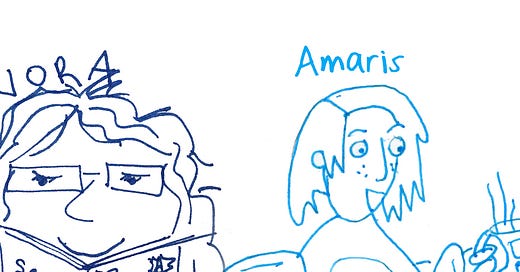So much depends on the seed being sown. The seed could come from a visit to a local museum or library, the challenge of a QWERTY flurry in November, or even the spark inspiration from a cool Instagram feed. The seed may lie dormant for several years. Just as actual seeds may require certain temperature cycles, scarification, or stratification, our own artistic awakenings may wait for the right conditions to germinate. Even though developing the habits of artistic practice—that is, of deliberate and consistent creation—can be so difficult, it is only the beginning stage of growth. To cultivate and spread creative work, writers and artists must hustle, but they must hustle in a way that is less coercive than collaborative. Even in times of drought, creative people must keep a mindset of abundance, that there is room for everyone to achieve their goals, because a fertile soil isn’t composed of competition but cooperation.
Our main resolution for 2023 is to become a better comics community citizen. But what does that look like?
The best way to foster this mindset is by joining artistic communities. In creative writing circles, we call this becoming a literary citizen, and there are many easy ways to participate in this kind of citizenship. First and foremost, read comics and graphic novels. Attend author readings and book signings, gallery shows, festivals, talks, and conferences. Celebrate your colleagues’ achievements and champion their work. Reach out to authors and artists you admire and tell them how much you appreciate their work. And most importantly, invite others into the community.
Want more specifics? Check out our list below -
Here are some ways to join and support the comics community in 2023:
try to visit a comic con or fair for the year: Angoulême is the grand pere of comics festivals, and maybe it’s not too late to nab some tickets for the event on 1/26-1/29! If not, follow along online and start saving for next year.
There’s also the San Diego Comic Con (and your local one!), the Small Press Expo, the Toronto Comic Arts Festival, Autopic, Graphic Medicine—as well as any number of cool local zine fests. Have others you would recommend? Add them to the comments!
Many of these also look for volunteers to help everything go smoothly.
a reading goal: perhaps you’ve heard of the FOLD reading challenge, where participants follow set parameters as they choose books to read. This can easily be adapted for the comics world, and bring you to books you may not have discovered!
subscribe time: comics have a long history of being subscriber-friendly, and the same is true today. You could try a creator’s subscription, like John Porcellino’s minicomics, or get a monthly mystery collection curated by Desert Island. Porcellino also runs a comix and zine distribution company, Spit and a Half, where other goodies can be found. Subscribe to comics substacks; we love what Sarah Shaw, Kelcey Ervick, Teresa Wong, and Jason McBride are up to, and we know there are many more (please note your faves in the comments below!).
write a fan letter to your favorite comics artist: everyone loves getting a little material love.
write Amazon and Goodreads reviews for your favorite indie published comics: if we gotta exist in Bezos’ world, we might as well try to do some good with it!
plan a comics exchange with friends.
join SAW’s free Friday Night Comics events on Youtube or host a "drink and draw" where you invite others out to draw together at your favorite cafe or brewery.
if you are interested in donating, you can investigate donating your old graphic memoirs to local libraries or donating to the Freedom to Read Foundation, which distributes grants to nonprofit organizations to support activities that raise awareness of intellectual freedom and censorship issues during Banned Books Week.
For those who want to cultivate a daily habit of drawing, here are a variety of prompts to get you back to the drawing board!
Take some inspiration from the poet Ross Gay and draw one thing each day that delights you. Remember that delight can be a small amusement—a certain kind of fruit, the funny thing your cat does, an activity you enjoy.
If you’re wanting to track your habits, keep a record by drawing something you ate that day, something you bought (à la Kate Bingaman-Burt), your exercise, your junk mail, or whatever you feel like keeping account of.
There’s always the classic Lynda Barry “Review Frame” diary exercise to practice paying attention to things you did, you saw, you overheard, and you questioned.
You can channel your inner James Kolchaka and draw a four-panel comic about something you did that day. (Titles are optional but fun.)
A variation of the four-panel comic is to draw four consecutive hours of your day, rendering one hour in each panel. This may make a story—or not.
If you are working through a project, you might want try a cinematic shots diary, exploring one panel from 2-4 different angles and compositions each day.
Or you can take inspiration from Tom Hart and look for metaphors in your life. What do you see each day that could be a visual metaphor in your project? (This exercise is fully described in The Art of the Graphic Memoir.)
Ivan Brunetti recommends a 12-panel approach in “I Observe.”
Try your hand at some haiku dairy comics.









Happy New Year! Thank you for including my newsletter in your list. I love all these suggestions—finally, some resolutions I can get behind!!
Happy New Year! Thanks for the shout-out, and the drawing tips! I love the cinematic shots approach and the Brunetti exercise. I really enjoy your newsletter, and I'm looking forward to reading more in the new year.